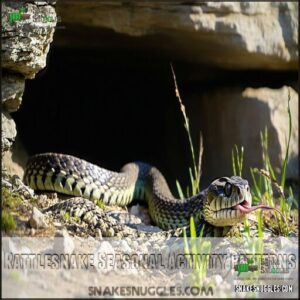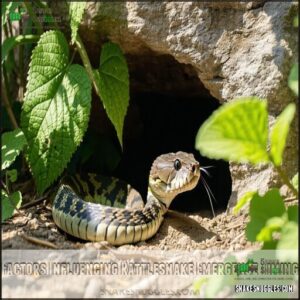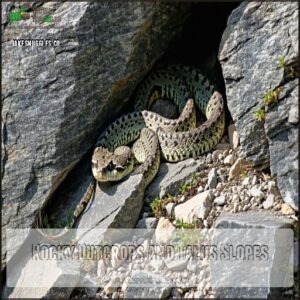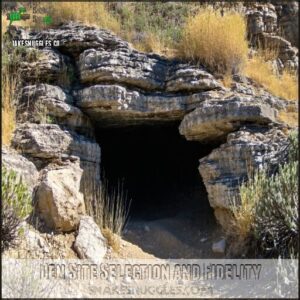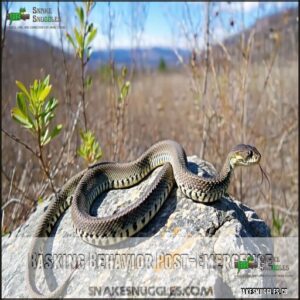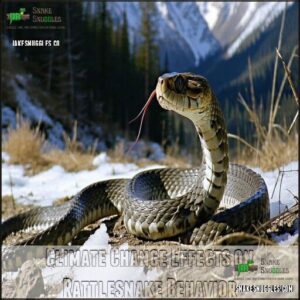This site is supported by our readers. We may earn a commission, at no cost to you, if you purchase through links.

You’ll see more activity in early mornings, evenings, or even at night, especially during summer. Timing depends on location and species—desert snakes may emerge earlier than their mountain relatives.
Keep an eye out near rocks, brush, or trails, as these spots offer warmth and cover. Knowing when rattlesnakes come out can help you stay safe and enjoy the outdoors.
Curious about their seasonal habits? Let’s explore more about how to stay safe!
Table Of Contents
- Key Takeaways
- Rattlesnake Seasonal Activity Patterns
- Factors Influencing Rattlesnake Emergence Timing
- Daily Activity Cycles of Rattlesnakes
- Rattlesnake Habitat Preferences and Movement
- Spring Emergence: When Rattlesnakes Become Active
- Summer Peak Activity of Rattlesnakes
- Fall Behavior and Preparation for Winter
- Regional Variations in Rattlesnake Activity
- Human-Rattlesnake Encounters: Timing and Prevention
- Climate Change Effects on Rattlesnake Behavior
- Frequently Asked Questions (FAQs)
- When are rattlesnakes most active?
- When do rattlesnakes come out?
- When are ratsnakes most active?
- What time of year do rattlesnakes hibernate?
- Do rattlesnakes come out at night?
- When can you see Rattlesnakes?
- What time are rattlesnakes most active?
- What makes rattlesnakes go away?
- At what temperature do rattlesnakes come out?
- What are rattlesnakes afraid of?
- Conclusion
Key Takeaways
- Rattlesnakes come out in spring when temperatures reach around 60°F, with their activity peaking during warmer months, from March to October.
- They’re most active at dawn and dusk, avoiding midday heat in hot climates and hunting at night when it’s cooler.
- Habitat matters—look for them near rocks, trails, or water sources, especially in areas with plenty of prey.
- To stay safe, stick to open trails, clear yard clutter, and use gear like snake gaiters when hiking in snake-prone areas.
Rattlesnake Seasonal Activity Patterns
Rattlesnakes follow predictable seasonal patterns, emerging in spring as temperatures rise and becoming most active during warmer months.
Their behavior shifts with the seasons, helping them regulate body temperature and adapt to available food and shelter, which is a key aspect of their behavior.
Spring Emergence From Hibernation
Spring signals rattlesnake emergence and their return to action after hibernation. As temperatures consistently climb above 68°F, these snakes leave their dens, driven by warmth and hunger. You’ll often spot their post-hibernation behavior near den sites.
Here’s what rattlesnakes are up to in spring:
- Emergence triggers include sunny days and rising temperatures.
- Basking begins, as they warm up near their dens.
- Shedding old skin is essential for a fresh start.
- First spring meals focus on small prey to boost energy.
- Den site departure happens gradually as activity ramps up.
Peak Summer Activity Periods
During summer, rattlesnake activity hits its stride, with Peak Movement shifting to early mornings and evenings as snakes avoid the scorching midday heat.
Peak summer movement occurs early morning and evening, avoiding midday heat while maximizing energy and hunting opportunities in cooler hours.
Thermoregulation tactics, like resting in shaded rocky hideouts, help them conserve energy during blistering daytime temperatures.
Warm nights often bring nocturnal activity, as snakes hunt under cover of darkness using their keen heat-sensing abilities.
You might spot them traversing their Home Ranges, engaging in Summer Foraging, or crossing paths with other wildlife.
Stay aware during these cooler hours, as rattlesnakes are most active and agile then.
Fall Mating Season
As cooler fall temperatures arrive, rattlesnake activity centers around mating rituals and preparation for hibernation.
During this time, you might notice increased activity near trails or rocky areas. Males compete for mates in dramatic wrestling matches, showcasing strength and dominance.
Here’s what to observe:
- Rattlesnake mating behavior involves male combat—fascinating but not something to get too close to!
- Venom production rises, potentially aiding survival during these intense encounters.
This phase highlights reproduction timing, hibernation migration prep, and regional variations in rattlesnake behavior. Proper care involves understanding nutrition during breeding to guarantee healthy offspring. Stay vigilant outdoors!
Winter Brumation Behavior
During winter, rattlesnakes enter brumation—similar to hibernation but more flexible.
Their metabolism drops, aiding winter survival, yet their awareness stays sharp.
They rest in dens, often rocky crevices or burrows, which they scrupulously choose for temperature stability (Den Site Selection).
Brumation physiology allows them to emerge briefly on warmer days, soaking up the sun before retreating.
Rattlesnake behavior during winter depends on regional brumation patterns and fluctuating temperatures.
Climate changes affect habits, possibly leading to earlier post-brumation emergence.
Always stay cautious near potential den sites on warm winter days, as this is a critical time for winter survival.
Factors Influencing Rattlesnake Emergence Timing
Rattlesnakes come out based on a mix of temperature, weather, and location, so you’ll notice them earlier in warm areas like the Southwest.
Specific species also follow their own rhythms, reacting to seasonal cues such as rising spring temperatures.
Geographic Location and Climate
When rattlesnakes appear depends heavily on their geographic location, microclimate, and seasonal patterns.
Their timing syncs beautifully with local temperatures, elevation, and regional climates.
Here’s a breakdown:
- Deserts: In Arizona, Texas, and California, rattlesnakes emerge early—often February—when deserts hit 70°F.
- Higher elevations: Mountains delay activity until April due to cooler temperatures.
- Coastal regions: Milder climates bring them out around March.
- Northern zones: Colder states like Maine remain snake-free, thanks to harsh winters.
From rocky outcrops to scrublands, rattlesnakes adapt to habitats, pairing activity perfectly with temperature thresholds across varying geographic locations and climate conditions.
Species-Specific Differences
Each snake species uniquely adapts to its habitat, making their behaviors fascinating and diverse.
Size variation, venom potency, and diet preferences shape their survival.
For example, Timber Rattlesnakes roam shady forests, active during cooler mornings or evenings.
Meanwhile, Eastern Diamondbacks prefer warm, sunny grasslands, hunting under the midday sun.
Mojave Rattlesnakes, famous for their potent venom, dominate desert nights, adapting to harsh conditions with precision.
In wetland environments, Eastern Massasaugas stick close to moisture-rich terrains, while Pygmy Rattlesnakes bask during sunny afternoons by marshes.
These habitat specializations highlight how geographic location influences rattlesnake behavior.
Knowing a snake’s natural preferences gives you insights into avoiding unwanted encounters while appreciating how they thrive amid the environmental challenges they face.
Environmental Cues for Emergence
When spring rolls in, temperature triggers and sunlight duration wake rattlesnakes from hibernation.
They’ll venture out as warm days climb above 60°F.
Keep an eye on:
- Temperature Triggers: Rising warmth signals activity.
- Rainfall Effects: Damp conditions boost prey availability.
- Food Availability: Increased prey movement sparks snake activity.
These subtle environmental cues shape snake activity patterns during spring emergence.
Understanding their burrowing and basking behaviors is also essential.
Impact of Weather Patterns
Shifting weather patterns shape rattlesnake activity like a hidden puppeteer.
Warm temperatures, spring rains, or sudden heat waves all hold sway.
Rainfall effects often draw rattlesnakes out, as prey emerges after showers.
Humidity influences their movements too—moisture-rich air entices them to stay active.
On windy days, expect less action since wind masks prey sounds.
Heat waves push snakes into nocturnal hunts, while cool days favor basking.
Extreme weather, like drought, drives rattlesnakes farther to find water.
| Weather Factor | Resulting Activity |
|---|---|
| Rainfall effects | Increased movement |
| Temperature drops | Visible daytime basking |
| Drought conditions | Roaming for water |
Stay safe by learning their behaviors!
Daily Activity Cycles of Rattlesnakes
You’ll notice rattlesnakes are most active during cooler parts of the day, like early morning and evening, when temperatures are just right for them.
They tend to avoid the midday heat, but in hotter regions, they may venture out at night to hunt and stay safe from scorching temperatures.
Morning Basking Habits
When sunlight creeps over the horizon, rattlesnakes waste no time. They spread out on warm rocks or patches of sun, soaking up the heat.
This morning ritual, driven by basking benefits, allows them to reach ideal temperatures for energy conservation and mobility. Without it, they’d be sluggish and vulnerable to predation risks.
During this quiet time of rattlesnake activity, you might spot them:
- Absorbing sunlight on rocks or trails.
- Staying close to sheltered spots for safety.
- Quietly scanning for morning prey nearby.
- Recharging after a cool night.
Midday Heat Avoidance Strategies
Keeping cool during the blazing midday heat isn’t easy, but rattlesnakes excel at it.
These crafty reptiles rely on Seeking Shade under rock crevices, burrow into cool soil, or nestle in dense brush. If the heat’s intense, some use Burrowing Behavior or rest near water—a natural refuge for maintaining their temperature.
Here’s how they adapt:
| Strategy | Purpose | Example |
|---|---|---|
| Seeking Shade | Avoid overheating | Rock crevices |
| Burrowing Behavior | Cool, stable environment | Loose sandy soil |
| Aestivation Periods | Long-term heat survival | Hotter summers |
This heat avoidance guarantees superior survival until basking resumes later.
Evening Hunting Patterns
As the sun dips, rattlesnakes slip into hunting mode, making dusk their prime time for action.
Their heat-sensing organs help detect nocturnal prey, like rodents, even in dim light, while their exceptional ambush skills guarantee precise venom delivery timing.
Cooler twilight hours inspire peak rattlesnake activity, as they rely on dusk hunting tactics to outwit predators and prey.
Stay alert during these hours to avoid surprises:
- Twilight Ambush: Snakes blend into trails, waiting for prey.
- Heightened Motion: Evening boosts their stalking instincts.
- Prey-Rich Environment: Rodent activity surges, fueling snake hunts.
Nocturnal Activity in Hot Regions
When the heat cranks up in desert regions, rattlesnakes adapt with Desert Nocturnalism, becoming active at night to avoid the scorching daytime temperatures.
Using their heat-sensing organs, they excel at Nocturnal Hunting, tracking prey with remarkable precision.
As temperatures dip at dusk, rattlesnake activity spikes, and their venom potency remains effective for defense and hunting.
These quiet nights aren’t limited to wilderness—Urban Encounters can happen too.
Stay vigilant during warm evenings to steer clear of these nocturnal hunters.
Rattlesnake Habitat Preferences and Movement
You’ll find rattlesnakes in habitats that offer plenty of cover, like rocky slopes, desert scrublands, or areas near water.
They’re always on the move to regulate their temperature and find food, but they stick close to places that meet their survival needs.
Rocky Outcrops and Talus Slopes
Rocky outcrops and talus slopes are prime rattlesnake habitats, thanks to their perfect balance of rock composition, slope aspect, and microclimates.
These rugged areas offer cozy retreats, ideal for evading predators, soaking up warmth, and hunting prey. Rattlesnakes love rocky areas for their dependable shelter and basking spots.
- Cracks and crevices in talus slopes provide hidden refuges.
- Sunny outcrops create microclimates for stable body temperatures.
- Abundant prey thrives in the rocky terrain near dens.
If you’re exploring elevated terrain, keep an eye out for unexpected rattlesnake sightings!
Sagebrush Flats and Desert Scrublands
Sagebrush flats and desert scrublands are prime rattlesnake habitats, offering abundant prey and effective camouflage. These open, arid spaces create perfect ambush sites for snakes lying in wait for unsuspecting rodents.
The landscape may look sparse, but it’s bustling with life.
- Scrubland ecology supports diverse prey, like mice and lizards, boosting prey abundance.
- Scattered vegetation provides desert camouflage, helping snakes hunt undetected.
- Extreme temperatures drive snakes to shade, highlighting their behavioral adaptations.
During rattlesnake season, these settings hide them well. Stay alert and wear thick boots—your next step might interrupt their hunt in this deceptively quiet terrain.
Riparian Areas and Water Sources
Rattlesnakes love riparian areas since water proximity creates perfect habitats for hunting and hydration.
Areas like riverbanks, floodplains, and springs/oases attract rattlesnakes with abundant prey and cooler zones. These shaded spots provide ideal conditions for resting and stalking.
When hiking near water, watch for tall grasses or vegetation—these are prime ambush zones. Snakes blend perfectly into the surroundings, so keep your eyes peeled and steps careful.
Water Source Why Rattlesnakes Visit Safety Tip
Den Site Selection and Fidelity
When winter rolls in, rattlesnakes retreat to carefully chosen dens, a decision paramount for hibernation success.
These dens aren’t just random spots; they’re chosen with precision, thanks to what experts call “fidelity factors.”
Rattlesnakes often return year after year to:
- Rocky crevices offering stable Den Microclimates.
- Abandoned burrows that double as secure shelters.
- Hillsides with deep fissures for Site Defense.
- Southern-facing slopes for natural warmth.
- Communal Dens shared by multiple snakes for temperature stability.
These preferences guarantee survival until spring.
Spring Emergence: When Rattlesnakes Become Active
As spring temperatures consistently surpass 60°F, rattlesnakes leave their winter dens and begin to reappear.
You’ll often spot them basking in sunny spots to warm up after months of inactivity, which can be a complete concept to understand their behavior.
Temperature Thresholds for Activity
Ectothermic creatures thrive on the environment’s warmth to power their bodies, and rattlesnakes are no different. Their activity range kicks in once ambient temperatures rise above 50°F, with optimal conditions hitting between 70-80°F.
These snakes have fantastic internal thermostats, tailoring their behaviors to the day’s heat. They may even exhibit nocturnal hunting techniques during the summer months.
Here’s how they manage body temperature regulation:
- They start moving when mornings warm past their minimum tolerance.
- Basking behavior helps soak up the sun on cooler mornings.
- When it’s too hot (above 95°F), they practice heat avoidance, retreating to shade.
- As evenings cool, activity pauses below 50°F, signaling hibernation triggers.
Their temperature preferences keep them thriving.
First Sightings After Winter
As temperatures climb past 60°F, snake season officially begins with spring emergence.
You’ll often spot the first rattlesnakes of the year between February and April, depending on where you live. Post-winter behavior focuses on warming up and staying near dependable shelter.
Look for their initial basking in these prime spots:
- Rocky ledges heated by the sun, perfect for soaking up warmth.
- South-facing slopes, which receive the day’s strongest sunlight.
- Den entrances where they stay close to their winter homes.
These early sightings reflect their cautious adjustment to renewed movement and an early spring diet.
Basking Behavior Post-Emergence
After shaking off hibernation, rattlesnakes greet spring by basking in sunlight to jumpstart their slowed metabolism.
They carefully choose sunning locations like warm rocks or bare soil, maximizing sunlight exposure. This basking behavior boosts their body temperature to ideal levels—usually between 80-90°F—for efficient movement and post-hibernation feeding preparation.
You’ll often find them stretched out, motionless, warming up for 30 minutes to two hours, depending on the day’s heat. Don’t assume they’re lethargic—they’re simply conserving energy.
Their heat-sensing organs fine-tune temperature regulation while keeping them alert to potential predators. So, watch your step near sunny outcrops during spring emergence to stay safe and avoid rattlesnakes, as they are conserving energy and may be motionless.
Feeding Patterns in Early Spring
A rattlesnake’s spring diet depends on its Post-Hibernation Diet to recover from winter’s fasting.
Once the sun warms the ground, these reptiles start hunting to meet their rising Metabolic Demands. Their Spring Foraging is opportunistic, targeting accessible prey.
You’ll likely find rattlesnakes foraging during mid-morning sun or early evening, with their venom potency optimized for efficiency.
Typical prey includes:
- Mice and voles nibbling on new vegetation
- Lizards basking on sun-heated rocks
- Ground squirrels scurrying across open spaces
- Baby rabbits hiding in shallow burrows
- Small birds feeding or nesting near the ground
If you’re hiking or gardening in early spring, stay alert—rattlesnake encounters often align with their search for prey.
Summer Peak Activity of Rattlesnakes
During summer, rattlesnakes are most active in the early morning, evenings, and sometimes at night when it’s cooler.
Their activity shifts to avoid the heat, allowing them to hunt and regulate their body temperature effectively.
Foraging and Hunting Behaviors
Summer is prime hunting season for rattlesnakes, and they’ve mastered the art of waiting. These predators are like nature’s patient hunters, relying on ambush tactics rather than chasing their meals.
They wait calmly, blending perfectly into their surroundings until prey—like rodents, birds, or lizards—gets too close to escape. With their heat-sensing organs, rattlesnakes detect prey in the dark, striking with precision and delivering venom that quickly incapacitates their targets.
Rattlesnakes tend to avoid the scorching midday sun, becoming most active at dusk or night when temperatures drop. You’ll often find them near water sources or trails, hunting for food.
- Note: Keep an eye on trails and shaded areas, especially when hiking in the evening. What looks like a stick could be an ambush-ready hunter. Stay alert, and give them space!
Thermoregulation Strategies
Managing body temperature is a full-time job for rattlesnakes during hot summer days. As ectotherms, they rely on external warmth to control their internal climate—a skill that keeps them active and efficient.
Here’s how they manage their day:
| Time | Behavior | Purpose |
|---|---|---|
| Early Morning | Basking on warm rocks | Heating up for movement |
| Late Morning | Staying in dappled sunlight | Balancing body temperature |
| Midday | Retreating to shaded burrows | Avoiding overheating |
| Evening/Night | Hunting as temperatures drop | Using heat-sensitive organs |
By hiding in cool spots at midday and adopting nocturnal shifts, they avoid heat stress. You’d seldom find one under the blazing sun.
These seasonal adaptations, paired with precise temperature regulation and basking behavior, guarantee survival. Their physiological mechanisms are like a thermostat, helping them thrive in climate-driven changes while staying one step ahead of their surroundings.
Movement Patterns and Home Ranges
Male snakes wander far and wide, especially during the breeding season when they search tirelessly for mates. They’re natural explorers, covering home range sizes often double that of females.
While rattlesnakes can seem unpredictable, their movement ecology follows clear patterns tied to survival needs. In summer, snake activity patterns show long-distance dispersal, especially in areas with abundant prey.
Droughts, however, can make movement limited and keep snakes closer to their core territories. Notably, rattlesnakes are loyal to their habitats—disrupting their rattlesnake range by moving them far from familiar ground typically harms their survival chances.
To better understand their patterns:
- Males roam farther during mating seasons.
- Dispersal patterns peak in summer.
- Territory defense is rare, but site fidelity is strong.
- Movement slows in dry or drought periods.
- Habitat loyalty drives most summer snake activity.
Interaction With Other Wildlife
When snakes share an ecosystem, they constantly navigate predator-prey dynamics and competition. Whether dodging hawks or hunting rodents, every interaction shapes their day.
Rattlesnakes are ambush experts, lying patiently in silence before striking small prey like mice or birds. Larger rattlesnake predators, such as coyotes and road runners, spark defensive coiling or rattling. It’s a delicate balance of food chains and survival.
Meanwhile, territorial scuffles with gopher snakes or kingsnakes can even change rattlesnake hunting grounds. These relationships highlight their essential role in maintaining the ecosystem’s equilibrium.
| Interaction | Species Involved | Rattlesnake Response |
|---|---|---|
| Predator-prey dynamics | Coyotes, hawks | Hide or rattle |
| Food competition | Gopher snake, kingsnake | Avoid conflict |
| Hunting prey | Mice, birds | Stealth ambush |
| Avoiding enemies | Roadrunners, badgers | Defensive retreat |
| Ecosystem impact | All wildlife nearby | Regulates local populations |
Understanding these interactions helps hikers anticipate movement and avoid surprising a rattlesnake on summer trails.
Fall Behavior and Preparation for Winter
As fall approaches, rattlesnakes become more active in preparation for winter, focusing on feeding and finding suitable dens.
You’ll notice them basking during the day to stay warm and moving toward protected hibernation sites as temperatures drop.
Pre-hibernation Feeding Frenzy
As cooler fall temperatures roll in, rattlesnakes gear up for hibernation with a vigorous feeding phase.
This pre-hibernation frenzy is their survival prep, where building energy reserves through fat storage becomes the top priority. You’ll see increased activity as they hunt in rodent-rich environments, stocking up for the months ahead.
Here’s what drives their behavior:
- Food consumption doubles compared to summer months to maximize fat storage.
- Hunting happens longer, often during cooler parts of the day.
- Prey abundance matters, with rodents like mice, squirrels, and rabbits being favorites.
- Ambush tactics intensify, making capture efforts more aggressive.
- Habitat choice shifts to areas with prey-rich conditions for efficiency.
These feeding habits peak weeks before winter hibernation starts.
Mating Rituals and Reproduction
As fall settles in, rattlesnakes enter their fascinating breeding season, showcasing unique courtship displays.
Males use their heat-sensing pits to track females’ pheromone trails with remarkable precision.
When rivals cross paths, they perform “combat dances,” twisting and wrestling to claim mating rights.
These battles can last hours, emphasizing their drive for reproductive success.
After mating, females begin a months-long gestation period, preparing to give birth to venomous offspring fully capable of survival.
Notably, females can store sperm to guarantee fertilization happens under ideal conditions.
Here’s what makes this process remarkable:
- Males may travel over a mile during breeding season.
- Rivalry often involves elaborate combat displays.
- Females typically birth 8-12 live young.
- Offspring emerge with venomous fangs and functional rattles.
- Courtship relies heavily on pheromone tracking.
Migration to Hibernation Sites
Ever wonder how rattlesnakes prepare for winter? When October’s cooler days settle in, they follow Migration Triggers like dropping temperatures and shorter daylight hours to head toward their hibernation dens.
These dens, carefully chosen for their stability, are often nestled in rocky outcrops or at lower elevations. Rattlesnakes show remarkable Route Fidelity, often trekking as far as two miles to return to the same spot each year.
Before winter hits, they gather for Communal Hibernation in dens called hibernacula, where the group stays safe from freezing conditions. This migration, driven by Predator Avoidance and survival instincts, guarantees they’re well-prepared for the months of inactivity.
Keep this in mind when exploring trails in fall, considering the importance of hibernacula for these animals.
Regional Variations in Rattlesnake Activity
Rattlesnake activity changes depending on where you are, with desert species staying active longer while others hibernate early.
Understanding these regional differences helps you stay safe and avoid surprising a snake in its natural habitat.
Desert Southwest Patterns
Rattlesnakes in the desert Southwest, especially in Arizona and California, showcase incredible desert adaptations that let them thrive in extreme conditions.
Instead of hibernating fully, they enter brumation during colder months. Rattlesnake season here typically runs from March through October, with activity dictated by temperatures rather than specific dates.
When daytime heat surpasses 90°F, rattlesnakes conserve energy, hunting at dawn and dusk. These Southwestern United States species benefit from prey abundance, but urban encroachment poses conservation challenges.
- Emergence Patterns: Warm temperatures trigger activity, even year-round in milder desert climates.
- Energy Management: Dawn and dusk offer ideal hunting times, avoiding midday heat.
Mountain West Behaviors
The Mountain West offers rattlesnakes a dramatic backdrop, shaping their behaviors through challenging terrain and changing conditions.
Compared to their desert cousins, these snakes navigate rocky landscapes, adapting to life at elevations reaching 5,300 feet with impressive precision.
During rattlesnake season (April through September), these reptiles align their movements with prey abundance, water proximity, and temperature.
You’ll find them basking on sunny, south-facing slopes in spring or retreating into talus slopes during the day’s heat.
Twilight hours are their prime hunting time, taking advantage of cooler temperatures and prey activity.
Rattlesnake behavior in this region reflects their need for specific habitats and conditions.
While exploring these areas, watch for snakes hiding in areas like:
- Shelter-providing rocky outcrops and sagebrush flats
- Water sources in valleys and riparian edges
- Vegetation-lined paths favored by prey
- South-facing slopes for warmth
- Quiet trails shrouded by dense scrub
Stay alert and practice rattlesnake safety!
Pacific Northwest Adaptations
Northern Pacific rattlesnakes, often found in Cascade habitats, have adapted impressively to the cooler Pacific Northwest.
While rattlesnake season typically peaks in warmer months, these snakes emerge early, basking on south-facing slopes to absorb heat. Shifts in rattlesnake behavior align with prey abundance and moderate climates, making hibernation zones an essential part of their survival.
Here’s a snapshot of their unique adaptations:
| Adaptation | Habitat | Timing | Impact |
|---|---|---|---|
| Hibernation Sites | South-facing slopes | Spring | Early emergence |
| Activity Periods | Rocky outcrops | Midday | Efficient thermoregulation |
| Prey Hunting Strategies | Dense forests | Evening | Matches prey availability |
| Urban Adaptation | Suburbs | Year-round | Increased human encounters |
Watching these coastal rattlesnakes reminds us: respect their habitats, and you’ll avoid unwanted surprises!
Eastern Rattlesnake Species Differences
Eastern rattlesnake species, found across the wooded landscapes of the Eastern United States, stand out with unique adaptations suited to their habitats.
Here are three key differences that make them distinct:
- Venom potency: Their venom is less lethal than that of Western species but perfectly suited to the smaller prey in their environment.
- Habitat distinctions: These snakes thrive in rocky outcrops, forested Karst regions, and leaf-littered woodlands, making them masters of camouflage.
- Behavior variations: Active in spring and fall when temperatures hit 70°F, they’re often cryptic, rattling less, which reduces encounters.
Unfortunately, their conservation status raises concerns, as habitat loss and human activity threaten their populations, emphasizing the need for understanding their role in local ecosystems.
Human-Rattlesnake Encounters: Timing and Prevention
You’re most likely to encounter rattlesnakes during their active seasons, typically from spring to early fall when temperatures range from 70-90°F.
To prevent accidental run-ins, stick to open trails, keep your yard clear of hiding spots, and always stay alert in snake-prone areas.
High-Risk Seasons for Encounters
The peak encounter months for rattlesnake season stretch from April to October, aligning with their most active periods.
Spring often brings sightings as snakes emerge from brumation starting in late February or March.
During summer, seasonal hazard awareness is key, especially near brushy trails, rocky outcrops, and rodent-filled areas.
When temperatures climb above 80°F, snakes adopt nocturnal habits, increasing bite incident rates for evening hikers.
High-risk trail times typically include dawn and dusk when they’re hunting or basking.
Staying aware of regional encounter hotspots and following safety tips will reduce your chances of surprise interactions.
Trail Safety During Active Periods
Rattlesnake season ramps up your need for trail awareness. Hiking during active periods? Keep these tips in mind for rattlesnake avoidance and safety:
- Stay alert by scanning the trail and using a hiking stick to nudge brush or shaded areas—rattlesnakes love to hide there during hot days.
- Use protective gear like snake gaiters, and pack essentials including a first aid kit designed for snake bites.
Consider using specialized hiking equipment for increased safety. Ditch headphones, as hearing rattles warns you faster than you’d expect. These simple steps make trail safety easier, keeping both your hike and encounters with rattlesnakes uneventful.
Yard Maintenance to Deter Snakes
Keeping rattlesnakes away starts with smart yard maintenance. Snakes love cozy hiding spots, so clear debris like brush piles, trash heaps, and leaf litter within 30 feet of your home. Mow regularly to reduce tall grass, which attracts both snakes and their prey.
Seal cracks around your foundation, pipes, and doors—snakes can squeeze through surprisingly small gaps. Don’t forget water control. Remove standing water, as it draws in rodents, which in turn invite snakes. Predator encouragement, like attracting birds of prey, can naturally aid in rattlesnake prevention.
A snake-proof fence offers great peace of mind. Consider installing a reliable barrier system for enhanced protection. Opt for mesh angled outward and buried several inches. Regular monitoring keeps defenses strong. Habitat adjustments work better than gimmicky repellents—focus on creating a less snake-friendly space.
| Task | Why It Helps | How Often |
|---|---|---|
| Clear Debris | Removes snake hiding spots | Weekly to Monthly |
| Mow Regularly | Reduces prey attractiveness | Weekly |
| Seal Cracks | Blocks snake entry points | Seasonally |
Educational Outreach Programs
To stay safe and foster coexistence, educational outreach programs play a pivotal role in increasing public awareness about rattlesnakes.
These programs teach you about rattlesnake behavior, safety practices, and conservation efforts, helping you feel less afraid and more prepared.
Here’s how communities spread rattlesnake education effectively:
- Wildlife centers host hands-on workshops to identify local snakes and understand their habits.
- Park rangers lead hikes where you’ll learn safe outdoor practices during active snake seasons.
- Herpetologists present at libraries, explaining seasonal behaviors and safety tips.
- Schools offer lessons with kid-friendly approaches to rattlesnake awareness.
- Community events provide demonstrations on safely responding to encounters.
Through these efforts, safety education and conservation messaging benefit you and your environment.
Climate Change Effects on Rattlesnake Behavior
You’ve probably noticed that climate change isn’t just affecting your weather apps—it’s also changing when and where rattlesnakes show up.
Warmer temperatures and shifting seasons are altering their activity periods, hibernation patterns, and even their hunting habits.
Shifting Activity Periods
Climate change is altering rattlesnake behaviors, reshaping both seasonal rhythms and daily activity cycles.
Warmer temperatures push their spring emergence earlier and extend their active periods into fall. These shifting activity periods mean you could encounter snakes during historically quiet months.
With rising daytime heat, many adopt more nocturnal activity, adjusting their daily rhythms to hunt at night. Temperature influence also disrupts hibernation, making their patterns less predictable.
Even prey availability sees changes, forcing regional adaptations among certain species. Always remain cautious, as rattlesnakes now challenge traditional assumptions about when and where they might appear in their habitats, due to climate change.
Range Expansion and Contraction
The warming climate is forcing rattlesnakes to rewrite their survival strategies, expanding into cooler territories while retreating from overheated regions.
These changes reflect the dramatic effects of habitat loss, prey availability, and human encroachment.
- Some southern populations are shrinking due to extreme heat, causing forced migration.
- Mountain corridors act as highways for movement, reshaping range expansion.
- Timber rattlers face shrinking ranges, while desert species adapt quickly to survive.
- Competition increases as overlapping habitats bring species into contact.
- Snakes now explore higher elevations, shifting ecosystems in unexpected ways.
Species adaptation to these climate effects showcases nature’s resilience, but every shift impacts biodiversity, leaving a trail of altered ecosystems and new predator-prey dynamics.
Altered Hibernation Patterns
When winters don’t feel like winters, rattlesnakes adapt in unexpected ways. Their hibernation patterns are shifting due to unpredictable temperatures, causing shorter brumation and erratic activity.
Here’s how altered hibernation patterns might show up:
- Snakes emerging weeks earlier in spring as temperatures rise.
- Shorter brumation periods, leaving snakes out and about longer.
- Delayed hibernation in fall, leading to unpredictable patterns.
- Warm winter spells triggering unexpected activity mid-season.
- Stress from fluctuating temperatures disrupting their rhythms.
These changes make snake hibernation habits more unpredictable. So, keep an eye out—your next outdoor hike might overlap their earlier emergence!
Impacts on Prey Availability
When prey is scarce, rattlesnakes don’t just sit around waiting for dinner—they adapt. Changes in prey abundance caused by climate shifts force these skilled hunters to adjust their routines.
Dwindling rodent populations, a rattlesnake’s go-to meal, complicate hunting success and upset predator-prey dynamics. Imagine chasing disappearing snacks!
Here’s how they cope:
- Track seasonal prey into new and unfamiliar terrains.
- Compete with other predators for shrinking food supplies.
- Shift feeding habits toward less common prey.
- Alter movement patterns to match food locations.
- Weather poor hunting seasons by relying on stored reserves.
It’s survival by strategy, not chance! Rattlesnakes also use tail movements and vibrations to deter threats.
Frequently Asked Questions (FAQs)
When are rattlesnakes most active?
Think of rattlesnakes as nature’s early risers; they’re most active from March to October, especially at dawn and dusk.
They prefer temperatures between 70-90°F, adjusting their schedule to avoid extreme heat or cold.
When do rattlesnakes come out?
Rattlesnakes typically come out in spring when temperatures hit around 60°F and stay active through October.
They’re busiest at dawn or dusk, especially during warmer months, but may hide midday in extreme heat.
When are ratsnakes most active?
Ratsnakes are most active during warmer months, especially from spring to early fall.
You’ll usually spot them hunting during the day, but in hot weather, they might shift to evening or early morning activity.
What time of year do rattlesnakes hibernate?
You know, when the weather cools down, rattlesnakes hit the snooze button.
They hibernate from November to February, escaping the cold in dens or burrows, only emerging occasionally if temperatures briefly rise above 60°F.
Do rattlesnakes come out at night?
Yes, they can, especially on warm nights when temperatures stay above 70°F.
In summer, they often shift activity to nighttime to avoid the heat, so use a flashlight and stay alert while hiking.
When can you see Rattlesnakes?
“Early bird gets the worm” applies to rattlesnakes too.
You’ll spot them most in spring and early fall, during dawn or dusk, when temperatures are 70-90°F.
Stay alert, especially March through October, as this is when they are most active.
What time are rattlesnakes most active?
Rattlesnakes are busiest during warmer months, especially at dawn and dusk when temperatures hit their sweet spot of 70-90°F.
They’re crepuscular and shift activity as needed, avoiding extreme heat or cold.
What makes rattlesnakes go away?
To keep rattlesnakes away, remove clutter like brush piles or tall grass, seal cracks in structures, and avoid leaving pet food outside.
Vibrations, like stomping, can also encourage them to move along peacefully.
At what temperature do rattlesnakes come out?
When temperatures consistently reach 60°F or higher, rattlesnakes start to emerge, especially in spring.
They’re most active in the 70-90°F range, seeking warmth to hunt and bask.
Cooler weather keeps them in hiding.
What are rattlesnakes afraid of?
Snakes fear anything larger or louder than them.
Vibrations, like stomping your feet, often scare them away.
They avoid predators like hawks, roadrunners, and humans.
So, stay confident and calm—it’s you they’re avoiding!
Conclusion
Imagine this: rattlesnakes emerging like clockwork as temperatures warm, marking another season of activity.
Knowing when rattlesnakes come out helps you stay safe while exploring their habitats.
Watch for them in spring as they bask in the sun or during cooler hours in summer.
Factors like location, species, and weather influence their timing, so staying alert near rocks and trails is key.
With knowledge and caution, you can enjoy outdoor adventures while coexisting peacefully with these fascinating reptiles.
- https://nationalzoo.si.edu/animals/news/do-snakes-have-ears-and-other-sensational-serpent-questions
- http://reptile-database.reptarium.cz/advanced_search?genus=Crotalus&submit=Search
- https://web.archive.org/web/20160916042649id_/http://jeb.biologists.org/content/jexbio/201/6/837.full.pdf
- https://en.wikipedia.org/wiki/Rattlesnake
- https://wildbitesback.com/how-to-protect-against-venomous-snake-bites/

